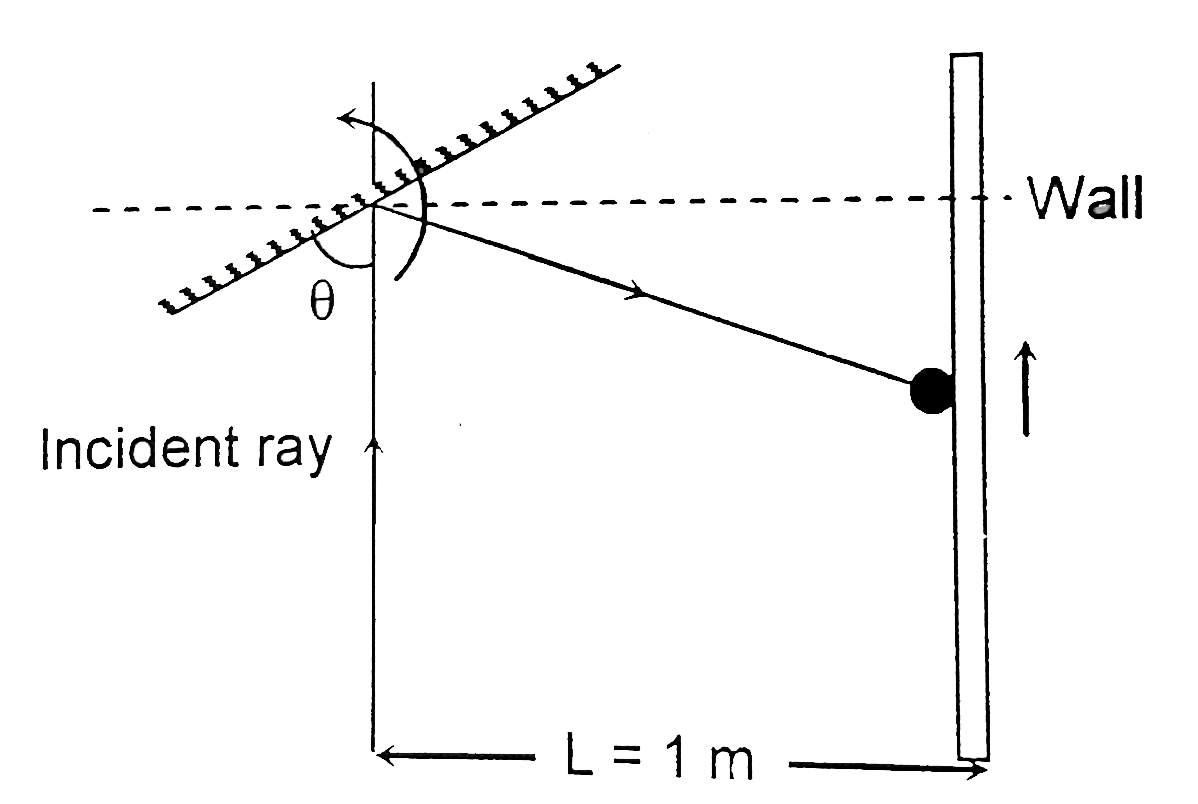A light ray I is incident on a plane mirror M.The mirror is rotated in the direction as shown in the figure by an arrow at frequency 9πrev/sec,The light reflected by the mirror is received on the wall W at a distance 10mfrom the axis of rotation .When the angle of incidence becomes 37∘find the speed of the spot (a point) on the wall?
 Solution in Gujrati
Solution in Gujrati
10 m/s
1000 m/s
360 m/s
None of these
The correct Answer is:B
_E01_049_S01.png)
As we know the ωreflected ray=2ωmirror
ωR=2×2π×9π=18×2=36∴vScos37∘=v
vS=vsec53∘=RωRsec53∘=10(sec53∘)2×18
=10×(53)2×18×2=1000m/s
Topper's Solved these Questions
- GEOMETRICAL OPTICSBOOK - ALLEN CHAPTER - GEOMETRICAL OPTICSEXERCISE - EXERCISE-3
12 Videos
- GEOMETRICAL OPTICSBOOK - ALLEN CHAPTER - GEOMETRICAL OPTICSEXERCISE - EXERCISE-04[A]
23 Videos
- GEOMETRICAL OPTICSBOOK - ALLEN CHAPTER - GEOMETRICAL OPTICSEXERCISE - EXERCISE- 01
45 Videos
- CURRENT ELECTRICITYBOOK - ALLEN CHAPTER - CURRENT ELECTRICITYEXERCISE - EX.II
66 Videos
- GRAVITATIONBOOK - ALLEN CHAPTER - GRAVITATIONEXERCISE - EXERCISE 4
9 Videos
Similar Questions
Plane mirrors are arranged parallel to each other as shown in column-I and the number of images formed by the combination is in column- II
_E01_090_S01.png)
View SolutionA plane mirror of circular shape with radius r=20cm is fixed to the ceiling .A bulb is to be placed on the axis of the mirror.A circular area of radius R=1m on the floor is to be illuminated after reflection of light from the mirror. The height of the room is 3m What is maximum distance from the center of the mirror and the bulb so that the required area is illuminated?
View SolutionTwo plane mirror M1andM2 are inclined to each other at 70∘. A ray incident on the mirror M1 at an angle θ fallls on M2 and is then reflected parallel to M1 for
View SolutionIn the Bohr's model of hy drogen atom, the electron moves around the nucleus in a circular orbit of radius 5×10−11m. Its time period is 1.5×10−16s. The current associated with the electron motion is:-
View SolutionAssertion : The difference in the value of acceleration due to gravity at pole and equator is proportional to square of angular velocity of earth.
Reason : the value of acceleration due to gravity is minimum at the equator and maximum at the pole.
View SolutionShow that a ray of light reflected from a plane mirror rotates througha an angle 2θ when the
mirror is rotated through an angle θ about its axis perpendicular to both the incident ray and
the normal to the surface.
View SolutionA light ray I is incident on a plane mirror M .The mirror is rotated in the direction as shown in the figure by an arrow at frequency (9)/(pi) "rev"//"sec" ,The light reflected by the mirror is received on the wall W at a distance 10m from the axis of rotation .When the angle of incidence becomes 37^(@) find the speed of the spot (a point) on the wall?
View SolutionA light ray is incident on a rotating mirror, which is rotating with angular speed 3rad/s as shown in figure. The speed of bright spot on the wall when θ=30∘

View SolutionFigure shows a plane mirror onto which a light rays is incident. If the incident light ray is rotated by 10^(@) and the mirror by 20^(@) , as show in figure below, find the angle by which the reflected ray is rotated.
View SolutionA ray of light is incident on a plane mirror, making an angle 'q' with the surface of the mirror. Arrange the following steps in sequential order to calculate the angle between the incident light ray and the reflected light ray.
(A) Draw a normal line on the plane mirror at the point of incidence of the light ray.
(B) Note down the angle between the plane mirror and the incident light ray.
(C) The sum of the angle of incidence and the angle between the plane mirror and the incident ray is 90∘.Determine the angle of incidence.
(D) From the laws of reflection, the angle of incidence is equal to the angle of reflection. Then the sum of the angle of incidence and the angle of reflection gives the angle between the incident light ray and the reflected light ray.
View SolutionA ray of light is incident on a plane mirror placed horizontally. When the mirror is rotated through an angle 30^(@) the reflected ray is found to be directed along the vertical. Determine the angle of incidence at the initial position of the mirror.
View Solutionआपतित किरण की दिशा को स्थिर रखकर समतल दर्पण को θ कोण से घुमाया जाता है तो परावर्तित किरण कितने कोण से घूम जायेगी?
View SolutionBy what angle the mirror must be rotated such that the reflected ray becomes vertical. Let the light ray incident on the plane mirror with an angle of incidence theta with respect to horizontal
View SolutionA plane mirror reflecting a ray of incident light is rotated through an angle theta about an axis through the point of incidence in the plane of the mirror perpendicualr to the plane of incidence, then
View SolutionA plane mirror, reflecting a ray of incident light, is rotated through an angle θ about an axis through the point of incidence in the plane of the mirror perpendicular to the plane of incidence, then
View Solution
